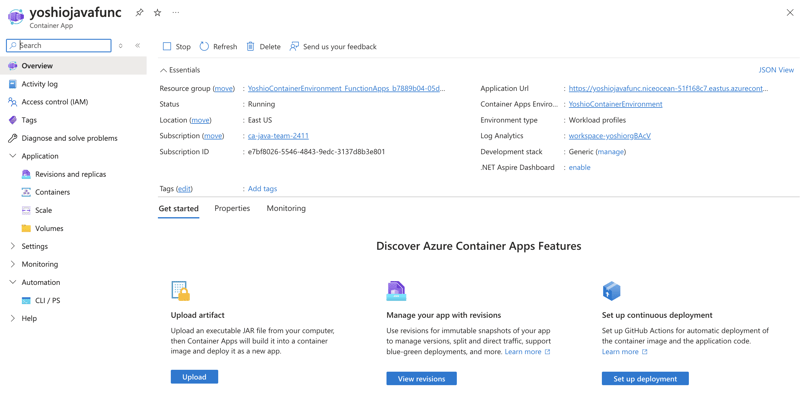Azure Functions を Azure Container Apps にデプロイする 2 つの方法の比較
昨日、「Azure Container Apps に Java Azure 関数をデプロイする」というタイトルの記事を書きました。
そのエントリでは、Azure の統合管理機能の使用について言及しましたが、それが何を意味するのか、そしてそれがこの記事で以前の方法とどのように異なるのかを明確にしたいと思います。
古い方法: az contextapp create を使用して作成する
Azure Container Apps は、Azure のコンテナー実行環境の 1 つであり、コンテナー化されたサービスを実行できます。以前は、Azure Container Apps で Azure Functions を実行する場合は、次のコマンドを使用してインスタンスを作成していました。
az containerapp create \ --name general-container-app \ --resource-group $RESOURCE_GROUP_NAME \ --environment $CONTAINER_ENVIRONMENT \ --registry-server $CONTAINER_REGISTRY_SERVER \ --image $CONTAINER_REGISTRY_SERVER/$C_IMAGE_NAME:$C_IMAGE_TAG \ --target-port 80 \ --ingress external \ --query properties.configuration.ingress.fqdn
コマンドを実行すると、次のようなメッセージが表示されます。
Container app created. Access your app at https://general-container-app.niceocean-********.eastus.azurecontainerapps.io/
その後、curl コマンドを使用して Azure Functions サービスに接続できます。
curl https://general-container-app.niceocean-********.eastus.azurecontainerapps.io/api/httpexample?name=World
Azure Container Apps 環境にアクセスすると、general-container-app がコンテナ アプリとして作成され、この管理インターフェイスはデプロイされたコンテナ化されたアプリケーションで利用できることがわかります。

https://raw.githubusercontent.com/yoshioterada/Azure-Functions-Deploy-To-Azure-Container-Apps/main/images/ACA-Instance-for-Azure-Functions.png
新しいメソッド: az functionapp create を使用して作成する
新しい方法では、az contextapp create の代わりに az functionapp create コマンドを使用して、Azure Container Apps で Azure Functions を作成できます。
az functionapp create \ --name $AZURE_FUNCTION_NAME \ --resource-group $RESOURCE_GROUP_NAME \ --environment $CONTAINER_ENVIRONMENT \ --storage-account $STORAGE_NAME \ --workload-profile-name "Consumption" \ --max-replicas 15 \ --min-replicas 1 \ --functions-version 4 \ --runtime java \ --image $CONTAINER_REGISTRY_SERVER/$C_IMAGE_NAME:$C_IMAGE_TAG \ --assign-identity
このコマンドを使用すると、Azure Functions が Azure Container Apps に作成され、管理インターフェイスにはそれが Function App であることが明確に表示されます。

これは、Azure Functions が専用の Azure Functions 管理インターフェイスを通じて管理できるようになり、他のコンテナー アプリケーションとは異なることを意味します。
ただし、Azure App Service で提供される管理機能と、コンテナ アプリ上の Azure Functions で利用できる管理機能の間には、いくつかの違いがあります。たとえば、診断ツール、展開機能などの特定の機能が利用できない場合があります。

参考: App Service 上の Azure Functions (ポータル)
比較のために、Azure App Service にデプロイされた Azure Functions の管理インターフェイスを次に示します。

App Service と Azure Container Apps の管理機能には次のような違いがあります。

- ピックアップ:
- Diagnose and solve problems - Microsoft Defender for Cloud - Events (preview) - Log stream - Deployment - App Service plan - Development Tools - Monitoring - Support + troubleshooting
特定の機能がないということは、機能が欠落していることを示唆していると考える人もいるかもしれません。
ただし、Azure Container Apps にデプロイすると、オペレーティング環境はコンテナベースになるため、デプロイと管理の方法が変わります。 Azure Functions 管理インターフェイスに含まれていない機能は、Azure Container Apps インターフェイスを通じて個別に管理する必要があります。
Azure Container Apps でのコンテナーの管理
az functionapp create コマンドを使用して Azure Container Apps 上に Azure Functions インスタンスを作成すると、コンテナー インスタンスを収容する新しいリソース グループが自動的に作成されます。

私の環境では、リソース グループ名は次の規則に従います:
$CONTAINER_ENVIRONMENT_FunctionApps_$UUID
指定した $AZURE_FUNCTION_NAME にちなんで名付けられた Azure Container Apps インスタンスが生成されたことがわかります。
このインスタンスをクリックすると、Azure Container Apps に固有の管理インターフェイスに移動し、そこで Azure Functions がコンテナー インスタンスとして実行されます。

Azure Container Apps は、Azure App Service とは異なる CI/CD およびデプロイ方法を提供します。また、Dapr や Service Connector など、コンテナー レベルで提供される機能を利用できるようになります。
Conclusion
Previously, it was possible to run Azure Functions by containerizing them in a container execution environment, but there was no dedicated management interface for Azure Functions.
With this new method, Azure Functions and Azure Container Apps have integrated, offering a container environment with an associated Azure Functions management interface.
I know some customers operate Azure Functions Container on Azure Kubernetes Service (AKS). Previously, they lacked a dedicated management interface. However, by deploying to Azure Container Apps, they can now use Azure Functions management while enjoying the simplicity of managing Azure Container Apps compared to managing operations on AKS.
The methods for deploying Azure Functions to Azure Container Apps are likely to evolve further. I look forward to seeing how this develops.
以上がAzure Functions を Azure Container Apps にデプロイする 2 つの方法の比較の詳細内容です。詳細については、PHP 中国語 Web サイトの他の関連記事を参照してください。

ホットAIツール

Undresser.AI Undress
リアルなヌード写真を作成する AI 搭載アプリ

AI Clothes Remover
写真から衣服を削除するオンライン AI ツール。

Undress AI Tool
脱衣画像を無料で

Clothoff.io
AI衣類リムーバー

Video Face Swap
完全無料の AI 顔交換ツールを使用して、あらゆるビデオの顔を簡単に交換できます。

人気の記事

ホットツール

メモ帳++7.3.1
使いやすく無料のコードエディター

SublimeText3 中国語版
中国語版、とても使いやすい

ゼンドスタジオ 13.0.1
強力な PHP 統合開発環境

ドリームウィーバー CS6
ビジュアル Web 開発ツール

SublimeText3 Mac版
神レベルのコード編集ソフト(SublimeText3)

ホットトピック
 1673
1673
 14
14
 1429
1429
 52
52
 1333
1333
 25
25
 1278
1278
 29
29
 1257
1257
 24
24
 会社のセキュリティソフトウェアはアプリケーションの実行に失敗していますか?それをトラブルシューティングと解決する方法は?
Apr 19, 2025 pm 04:51 PM
会社のセキュリティソフトウェアはアプリケーションの実行に失敗していますか?それをトラブルシューティングと解決する方法は?
Apr 19, 2025 pm 04:51 PM
一部のアプリケーションが適切に機能しないようにする会社のセキュリティソフトウェアのトラブルシューティングとソリューション。多くの企業は、内部ネットワークセキュリティを確保するためにセキュリティソフトウェアを展開します。 ...
 名前を数値に変換してソートを実装し、グループの一貫性を維持するにはどうすればよいですか?
Apr 19, 2025 pm 11:30 PM
名前を数値に変換してソートを実装し、グループの一貫性を維持するにはどうすればよいですか?
Apr 19, 2025 pm 11:30 PM
多くのアプリケーションシナリオでソートを実装するために名前を数値に変換するソリューションでは、ユーザーはグループ、特に1つでソートする必要がある場合があります...
 MapsTructを使用したシステムドッキングのフィールドマッピングの問題を簡素化する方法は?
Apr 19, 2025 pm 06:21 PM
MapsTructを使用したシステムドッキングのフィールドマッピングの問題を簡素化する方法は?
Apr 19, 2025 pm 06:21 PM
システムドッキングでのフィールドマッピング処理は、システムドッキングを実行する際に難しい問題に遭遇することがよくあります。システムのインターフェイスフィールドを効果的にマッピングする方法A ...
 Intellijのアイデアは、ログを出力せずにSpring Bootプロジェクトのポート番号をどのように識別しますか?
Apr 19, 2025 pm 11:45 PM
Intellijのアイデアは、ログを出力せずにSpring Bootプロジェクトのポート番号をどのように識別しますか?
Apr 19, 2025 pm 11:45 PM
intellijideaultimatiateバージョンを使用してスプリングを開始します...
 エンティティクラス変数名をエレガントに取得して、データベースクエリ条件を構築する方法は?
Apr 19, 2025 pm 11:42 PM
エンティティクラス変数名をエレガントに取得して、データベースクエリ条件を構築する方法は?
Apr 19, 2025 pm 11:42 PM
データベース操作にMyBatis-Plusまたはその他のORMフレームワークを使用する場合、エンティティクラスの属性名に基づいてクエリ条件を構築する必要があることがよくあります。あなたが毎回手動で...
 Javaオブジェクトを配列に安全に変換する方法は?
Apr 19, 2025 pm 11:33 PM
Javaオブジェクトを配列に安全に変換する方法は?
Apr 19, 2025 pm 11:33 PM
Javaオブジェクトと配列の変換:リスクの詳細な議論と鋳造タイプ変換の正しい方法多くのJava初心者は、オブジェクトのアレイへの変換に遭遇します...
 eコマースプラットフォームSKUおよびSPUデータベースデザイン:ユーザー定義の属性と原因のない製品の両方を考慮する方法は?
Apr 19, 2025 pm 11:27 PM
eコマースプラットフォームSKUおよびSPUデータベースデザイン:ユーザー定義の属性と原因のない製品の両方を考慮する方法は?
Apr 19, 2025 pm 11:27 PM
eコマースプラットフォーム上のSKUおよびSPUテーブルの設計の詳細な説明この記事では、eコマースプラットフォームでのSKUとSPUのデータベース設計の問題、特にユーザー定義の販売を扱う方法について説明します。
 Redisキャッシュソリューションを使用して、製品ランキングリストの要件を効率的に実現する方法は?
Apr 19, 2025 pm 11:36 PM
Redisキャッシュソリューションを使用して、製品ランキングリストの要件を効率的に実現する方法は?
Apr 19, 2025 pm 11:36 PM
Redisキャッシュソリューションは、製品ランキングリストの要件をどのように実現しますか?開発プロセス中に、多くの場合、ランキングの要件に対処する必要があります。




